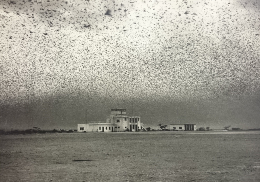
CICLE TÒXICS (IN)VISIBLES
Seminari impartit per Sabine Clarke, Senior Lecturer in Modern History, University of York
Data: Dimecres 6 de novembre de 2019 a les 16 hores
Lloc: Sala de conferències. Palau de Cerveró. Instittut Interuniversitari López Piñero.
Organitza: José Ramón Bertomeu (IILP-UV) i Ximo Guillem (IILP-UV) amb la col·laboració de SCHCT.
Coordinació de seminaris: Enric Novella (IILP-UV).
El seminari es pot seguir en línia a temps real a: http://reunion.uv.es/hcc2
Pick your poison: insecticides and locust control in colonial Kenya
Literature on the use of insecticides in the tropics after 1945 is preoccupied with the WHO’s Malaria Eradication Programme. This scholarship describes a form of technological hubris in which scientists rushed to deploy the quick fix of DDT on the widest possible scale, fuelled by belief in the power of Western science and buoyed by Allied victory. This paper focuses on trials to control locusts in Kenya after 1945 using synthetic insecticides to tell a different story. It shows that discussion about synthetic insecticides in Britain’s African colonies was not characterised by calls for rapid and far-reaching application of new chemicals. Caution arose in part because of concern about the costs of new programmes. This reflected the weaker economic position of Britain in comparison to the USA, backers of the WHO programme, but more importantly, new locust control substances such as gammexane were evaluated in Kenya against pre-existing ones. In other words, the notion that DDT and related chemicals were wonder weapons of such power that they marked a radical departure from past measures, and rendered all previous insect control methods obsolete, is not borne out by this study. The use of the new insecticides was dependent upon calculations of advantage versus cost in comparison to well-established existing methods. In addition, previous experience with arsenic bait and pyrethrum shaped the testing and deployment of gammexane in significant ways, including evaluation of its toxicity. The perception of the new chemicals as part of a continuum of poisons also informed the attitudes of Kenyan herdsmen. Their suspicion of gammexane was not merely the result of a distrust of Western science and the colonial government, but arose directly from the experience of seeing their cattle poisoned by arsenic bait during the interwar years.
Biography
Dr Sabine Clarke has a PhD in History from the Centre for the History of Science, Technology and Medicine at Imperial College in London and is Senior Lecturer in Modern History at the University of York. She works on the history of science, technology and medicine in Britain and its colonial empire between WWI and 1965, with a particular focus on the Caribbean and East Africa. Her monograph, Science at the End of Empire: Experts and the Development of the British Caribbean, 1940-1965 was published by Manchester University Press in September 2018. Her current project is called "The Chemical Empire: a New History of Synthetic Insecticides in Britain and its Colonies, c.1920-1965" and is funded by the Wellcome Trust.









